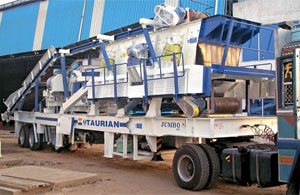
The major challenge we face is the lack of trained operators
Tell us about the range of crushers and screens offered by Taurian.
We have crushers from 50 TPH to 500 TPH capacity. We are developing a new range of crusher, which can provide the customer the cost benefit. It will be user-friendly as well. The product will be available in the market in a year. Major technology developments are not happening in crushers and screens, but only new features are being added.
Are domestic players losing ground due to lack of demand and heavy competition from the global players?
Actually, the domestic players are gaining ground because of the volatile currency situation. In this scenario, it is not feasible for anyone to import. Indian plant manufacturers are getting the benefit of this situation.
Another thing is that most of the Indian players are not into track-mounted plants while the foreign players are [mostly] into it. For the last few years, the market for track-mounted plants is quite low. Whatever business is coming from aggregate sector, and here, domestic players are getting their foothold better.
Are you into any JV or technical collaborations?
Taurian had a tie-up with Astec long back for selling equipment. But it did not pick up because Astec machines were very costly and Indian market was not ready [at that time] to accept those equipment. Now we have the technology to make crushers and we need not have a technology partner. We make cone crushers with the latest technology and are even developing a new kind of cone crusher, which may be in the market in a year. We are developing the machine to compete with Indian brands rather than competing with the international brands. So we have the advantage of keeping the cost low with cost-effective machines.
What are the challenges that Taurian face as an OEM and service provider?
The major challenge we face is the lack of trained operators. Earlier the road builders, who are corporates, used to buy plants for their projects and they maintained the machines with experienced and trained people. Now they are not buying machines, but outsourcing. Here the plant owner has a lean set up with no trained engineer and the operator does not even read the manual. So, ultimately the maintenance of the machines comes on the shoulders of the OEM.
How do you address the issue of lack of skilled operators? Companies like us cannot have infinite number of people for service and there are limited number of people available in the market for such kinds of jobs. So we are trying to train personnel from our customers. But at the same time we cannot train all of them. How can we train a person who cannot read a manual?
Now, we are trying to publish the manual in Hindi, which will help the operators who cannot read English. The more they know, the less they require us to attend the problems. We have been providing training to customers for the last ten years.


 +91-22-24193000
+91-22-24193000 Subscriber@ASAPPinfoGlobal.com
Subscriber@ASAPPinfoGlobal.com